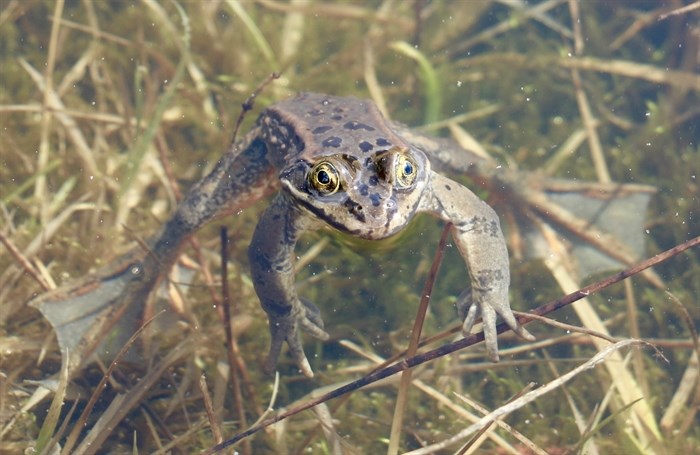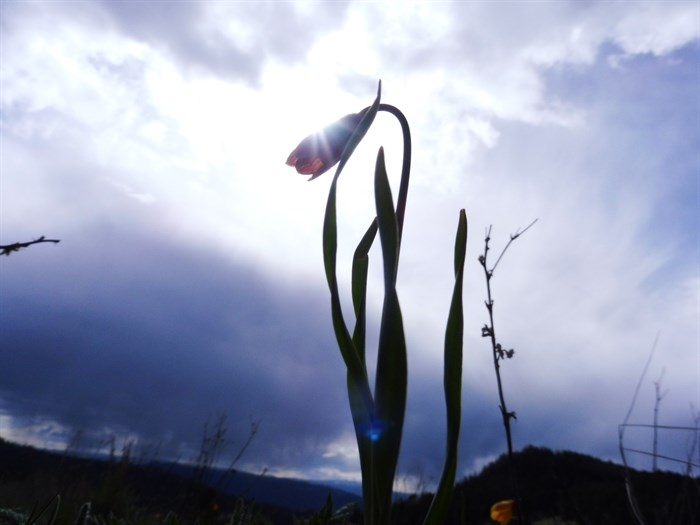Science
Nanaimo Astronomy Society guest speaker warns about ‘intruder’ satellites in the night sky

|
|
The Nanaimo Astronomy Society’s next guest speaker is advising everyone to get out and enjoy clear, dark night skies while they still can.
Patrick Seitzer, research professor emeritus with the University of Michigan’s department of astronomy, estimates that over the next 10 years, more than 400,000 new satellites are planned to be launched into low Earth orbit, adding to the 50,000 low Earth orbit objects that are currently tracked and catalogued. He warns that most, maybe even all, of those objects could be visible to the unaided eye, even in light-polluted skies.
Seitzer specializes in making optical observations of space debris and has worked on the problem of having large numbers of bright satellites and their visual effect on the night sky.
“Since I was very young I was always interested in the stars and I wanted to study them and learn more about them and space travel … through great luck and hard work I was able to make a career our of it,” he said. “I’ve been exceptionally lucky to follow my dream since I was a kid.”
During his working career, he specialized in studying star clusters – how they’re formed, how the stars move between them, internal dynamics and galactic tidal field limitiations.
“In the late ’90s, I was working with a wide field telescope in Chile that the University of Michigan owns … and I began to notice more and more satellite trails in the images that I took,” Seitzer said. “That led me into space debris – what happens when satellites break up, when they fragment, what’s the population, and I was very lucky to be able to turn that into a NASA project, which was funded for 16 years, to study the population of space debris at geosynchronous orbit.”
When that project ended and Seitzer retired, the problem of bright satellites in the night sky became apparent when SpaceX laughed its first StarLink satellites in 2019. He began working with the American Astronomical Society and others on that problem.
“What can be done to make them fainter? How you handle it in astronomy? … Is it a real challenge to astronomers? The answer is yes,” he said. “We set goals to try to make them as faint or fainter, so you wouldn’t see them with the unaided eye and I think that’s going to be a tough goal to meet, but companies like SpaceX are certainly trying very hard to achieve that.”
Private companies such as SpaceX, Amazon, OneWeb, Samsung, Guo Wang and others have plans or are already launching tens of thousands of low Earth orbit satellites in what are called mega-constellations over the next few years, mostly to provide communication services.
According to a report from the U.S. Government Accountability Office last fall, so much orbiting hardware and in orbital debris could mean damage or destruction of satellites that could affect commercial services, scientific observations and even national security. Emissions into the upper atmosphere from rocket launches, along with particle emissions from vehicle and satellite re-entries could affect atmospheric temperatures and the ozone layer. The report also noted that large numbers of satellites don’t just reflect sunlight, they also transmit radio emissions that can interfere with astronomical natural phenomena observations.
“We’ll see how many of those [satellite constellation projects] come to fruition, but even if a small percentage of those come to fruition, say 50,000, it’s still a huge problem for astronomy,” Seitzer said.
He said more satellites are becoming visible all the time and the view of the night sky is changing rapidly, so he encourages people to seek out a dark sky site on a moonless night and just look at the night sky.
“It’s one of the most amazing shows that nature has to offer,” he said. “But there are these intruders, these new satellites that are coming in and many of which are very, very bright.”
Seitzer will be the guest speaker at the Nanaimo Astronomy Society’s first meeting of 2023 on Thursday, Jan. 26, at 7 p.m. at the Beban Park social centre. The meeting will also be held on Zoom for society members. For more information, visit www.nanaimoastronomy.com.





Science
Voyager 1 transmitting data again after Nasa remotely fixes 46-year-old probe – The Guardian


Earth’s most distant spacecraft, Voyager 1, has started communicating properly again with Nasa after engineers worked for months to remotely fix the 46-year-old probe.
Nasa’s Jet Propulsion Laboratory (JPL), which makes and operates the agency’s robotic spacecraft, said in December that the probe – more than 15bn miles (24bn kilometres) away – was sending gibberish code back to Earth.
In an update released on Monday, JPL announced the mission team had managed “after some inventive sleuthing” to receive usable data about the health and status of Voyager 1’s engineering systems. “The next step is to enable the spacecraft to begin returning science data again,” JPL said. Despite the fault, Voyager 1 had operated normally throughout, it added.
Launched in 1977, Voyager 1 was designed with the primary goal of conducting close-up studies of Jupiter and Saturn in a five-year mission. However, its journey continued and the spacecraft is now approaching a half-century in operation.
Voyager 1 crossed into interstellar space in August 2012, making it the first human-made object to venture out of the solar system. It is currently travelling at 37,800mph (60,821km/h).
The recent problem was related to one of the spacecraft’s three onboard computers, which are responsible for packaging the science and engineering data before it is sent to Earth. Unable to repair a broken chip, the JPL team decided to move the corrupted code elsewhere, a tricky job considering the old technology.
The computers on Voyager 1 and its sister probe, Voyager 2, have less than 70 kilobytes of memory in total – the equivalent of a low-resolution computer image. They use old-fashioned digital tape to record data.
The fix was transmitted from Earth on 18 April but it took two days to assess if it had been successful as a radio signal takes about 22 and a half hours to reach Voyager 1 and another 22 and a half hours for a response to come back to Earth. “When the mission flight team heard back from the spacecraft on 20 April, they saw that the modification worked,” JPL said.
Alongside its announcement, JPL posted a photo of members of the Voyager flight team cheering and clapping in a conference room after receiving usable data again, with laptops, notebooks and doughnuts on the table in front of them.
The Retired Canadian astronaut Chris Hadfield, who flew two space shuttle missions and acted as commander of the International Space Station, compared the JPL mission to long-distance maintenance on a vintage car.
“Imagine a computer chip fails in your 1977 vehicle. Now imagine it’s in interstellar space, 15bn miles away,” Hadfield wrote on X. “Nasa’s Voyager probe just got fixed by this team of brilliant software mechanics.
Voyager 1 and 2 have made numerous scientific discoveries, including taking detailed recordings of Saturn and revealing that Jupiter also has rings, as well as active volcanism on one of its moons, Io. The probes later discovered 23 new moons around the outer planets.
As their trajectory takes them so far from the sun, the Voyager probes are unable to use solar panels, instead converting the heat produced from the natural radioactive decay of plutonium into electricity to power the spacecraft’s systems.
Nasa hopes to continue to collect data from the two Voyager spacecraft for several more years but engineers expect the probes will be too far out of range to communicate in about a decade, depending on how much power they can generate. Voyager 2 is slightly behind its twin and is moving slightly slower.
In roughly 40,000 years, the probes will pass relatively close, in astronomical terms, to two stars. Voyager 1 will come within 1.7 light years of a star in the constellation Ursa Minor, while Voyager 2 will come within a similar distance of a star called Ross 248 in the constellation of Andromeda.
Science
iN PHOTOS: Nature lovers celebrate flora, fauna for Earth Day in Kamloops, Okanagan | iNFOnews | Thompson-Okanagan's News Source – iNFOnews


Photographers are sharing their favourite photos of flora and fauna captured in Kamloops and the Okanagan in celebration of Earth Day.
First started in the United States in the 70s, the special day on April 22 continues to be acknowledged around the globe. It’s a day to celebrate the planet and a reminder of the need for environmental conservation and sustainability, according to EarthDay.org.
These stunning nature photos show life in ponds and forests, in skies and on mountains, capturing the beauty and wonder of our local natural environments.
Area photographers shared some of their favourite finds and artistic captures. From frogs to flowers, the great outdoors is teeming with life.
If you have nature photos you want to share, send them to news@infonews.ca.








To contact a reporter for this story, email Shannon Ainslie or call 250-819-6089 or email the editor. You can also submit photos, videos or news tips to the newsroom and be entered to win a monthly prize draw.
We welcome your comments and opinions on our stories but play nice. We won’t censor or delete comments unless they contain off-topic statements or links, unnecessary vulgarity, false facts, spam or obviously fake profiles. If you have any concerns about what you see in comments, email the editor in the link above. SUBSCRIBE to our awesome newsletter here.


Science
An extra moon may be orbiting Earth — and scientists think they know exactly where it came from – Livescience.com


A fast-spinning asteroid that orbits in time with Earth may be a wayward chunk of the moon. Now, scientists think they know exactly which lunar crater it came from.
A new study, published April 19 in the journal Nature Astronomy, finds that the near-Earth asteroid 469219 Kamo’oalewa may have been flung into space when a mile-wide (1.6 kilometers) space rock hit the moon, creating the Giordano Bruno crater.
Kamo’oalewa’s light reflectance matches that of weathered lunar rock, and its size, age and spin all match up with the 13.6-mile-wide (22 km) crater, which sits on the far side of the moon, the study researchers reported.
China plans to launch a sample-return mission to the asteroid in 2025. Called Tianwen-2, the mission will return pieces of Kamo’oalewa about 2.5 years later, according to Live Science’s sister site Space.com.
“The possibility of a lunar-derived origin adds unexpected intrigue to the [Tianwen-2] mission and presents additional technical challenges for the sample return,” Bin Cheng, a planetary scientist at Tsinghua University and a co-author of the new study, told Science.
Related: How many moons does Earth have?
Kamo’oalewa was discovered in 2016 by researchers at Haleakala Observatory in Hawaii. It has a diameter of about 100 to 200 feet (approximately 30 to 60 meters, or about the size of a large Ferris wheel) and spins at a rapid clip of one rotation every 28 minutes. The asteroid orbits the sun in a similar path to Earth, sometimes approaching within 10 million miles (16 million km).
window.sliceComponents = window.sliceComponents || ;
externalsScriptLoaded.then(() => {
window.reliablePageLoad.then(() => {
var componentContainer = document.querySelector(“#slice-container-newsletterForm-articleInbodyContent-UG4KJ7zrhxAytcHZQxVzXK”);
if (componentContainer)
var data = “layout”:”inbodyContent”,”header”:”Sign up for the Live Science daily newsletter now”,”tagline”:”Get the worldu2019s most fascinating discoveries delivered straight to your inbox.”,”formFooterText”:”By submitting your information you agree to the Terms & Conditions and Privacy Policy and are aged 16 or over.”,”successMessage”:”body”:”Thank you for signing up. You will receive a confirmation email shortly.”,”failureMessage”:”There was a problem. Please refresh the page and try again.”,”method”:”POST”,”inputs”:[“type”:”hidden”,”name”:”NAME”,”type”:”email”,”name”:”MAIL”,”placeholder”:”Your Email Address”,”required”:true,”type”:”hidden”,”name”:”NEWSLETTER_CODE”,”value”:”XLS-D”,”type”:”hidden”,”name”:”LANG”,”value”:”EN”,”type”:”hidden”,”name”:”SOURCE”,”value”:”60″,”type”:”hidden”,”name”:”COUNTRY”,”type”:”checkbox”,”name”:”CONTACT_OTHER_BRANDS”,”label”:”text”:”Contact me with news and offers from other Future brands”,”type”:”checkbox”,”name”:”CONTACT_PARTNERS”,”label”:”text”:”Receive email from us on behalf of our trusted partners or sponsors”,”type”:”submit”,”value”:”Sign me up”,”required”:true],”endpoint”:”https://newsletter-subscribe.futureplc.com/v2/submission/submit”,”analytics”:[“analyticsType”:”widgetViewed”],”ariaLabels”:;
var triggerHydrate = function()
window.sliceComponents.newsletterForm.hydrate(data, componentContainer);
if (window.lazyObserveElement)
window.lazyObserveElement(componentContainer, triggerHydrate);
else
triggerHydrate();
}).catch(err => console.log(‘Hydration Script has failed for newsletterForm-articleInbodyContent-UG4KJ7zrhxAytcHZQxVzXK Slice’, err));
}).catch(err => console.log(‘Externals script failed to load’, err));
Follow-up studies suggested that the light spectra reflected by Kamo’oalewa was very similar to the spectra reflected by samples brought back to Earth by lunar missions, as well as to meteorites known to come from the moon.
Cheng and his colleagues first calculated what size object and what speed of impact would be necessary to eject a fragment like Kamo’oalewa from the lunar surface, as well as what size crater would be left behind. They figured out that the asteroid could have resulted from a 45-degree impact at about 420,000 mph (18 kilometers per second) and would have left a 6-to-12-mile-wide (10 to 20 km) crater.
There are tens of thousands of craters that size on the moon, but most are ancient, the researchers wrote in their paper. Near-Earth asteroids usually last only about 10 million years, or at most up to 100 million years before they crash into the sun or a planet or get flung out of the solar system entirely. By looking at young craters, the team narrowed down the contenders to a few dozen options.
The researchers focused on Giordano Bruno, which matched the requirements for both size and age. They found that the impact that formed Giordano Bruno could have created as many as three still-extant Kamo’oalewa-like objects. This makes Giordano Bruno crater the most likely source of the asteroid, the researchers concluded.
“It’s like finding out which tree a fallen leaf on the ground came from in a vast forest,” Cheng wrote on X, formerly known as Twitter.
Confirmation will come after the Tianwen-2 mission brings a piece of Kamo’oalewa back to Earth. Scientists already have a sample of what is believed to be ejecta from Giordano Bruno crater in the Luna 24 sample, a bit of moon rock brought back to Earth in a 1976 NASA mission. By comparing the two, researchers could verify Kamo’oalewa’s origin.
Editor’s note: This article’s headline was updated on April 23 at 10 a.m. ET.
-



 Health24 hours ago
Health24 hours agoSee how chicken farmers are trying to stop the spread of bird flu – Fox 46 Charlotte
-



 Science22 hours ago
Science22 hours agoOsoyoos commuters invited to celebrate Earth Day with the Leg Day challenge – Oliver/Osoyoos News – Castanet.net
-



 Politics22 hours ago
Politics22 hours agoHaberman on why David Pecker testifying is ‘fundamentally different’ – CNN
-
News22 hours ago
Freeland defends budget measures, as premiers push back on federal involvement – CBC News
-
Economy22 hours ago
The Fed's Forecasting Method Looks Increasingly Outdated as Bernanke Pitches an Alternative – Bloomberg
-



 Health21 hours ago
Health21 hours agoIt's possible to rely on plant proteins without sacrificing training gains, new studies say – The Globe and Mail
-
Business21 hours ago
Gildan replacing five directors ahead of AGM, will back two Browning West nominees – Yahoo Canada Finance
-



 Tech21 hours ago
Tech21 hours agoMeta Expands VR Operating System to Third-Party Hardware Makers – MacRumors









